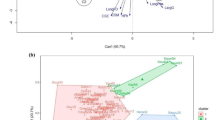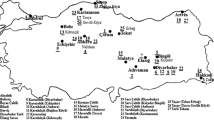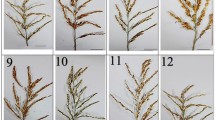Abstract
Glutinous Bora rice plays an important role in socio-economic and cultural livelihood of Boro tribes of Assam. However, neither systematic survey had been done, nor databanks are available on their detailed morpho-molecular characterization essential for breeding programme. Present study attempted to prepare a morphological database with molecular signature using a total of 22 Bora rice lines collected from upper Brahmaputra basin of Assam, which were phenotyped with 27 popular agro-morphological traits followed by marker based genotyping, sequence diversity study and expression profiling for selected genetic loci associated with low amylose content. Long day flowering and less number of tillers with panicles are the main discouraging traits of Bora rice that showed negative association with culm length. Among the 8 different phenotypic markers established, anthocyanin pigment in different parts of the plant and availability of awn may be used as identifying criteria for selection of the hybrid lines introgress with “Komal” trait. In marker based genotyping, all the studied marker loci were reported to be polymorphic with variable number of allelic forms and RM241 showed highest PIC value. In case of expression study, 5 days (after anthesis) old developing grains of selected Komal genotype (Aghani Bora) showed 90.9-fold down regulation of GBSSI (loci associated with amylose deposition in rice grain) with respect to the commonly grown popular rice (IR36). Phylogenetic relationship study with 5 different rice genomes (O. rufipogon, O. glaberrima, O. sativa japonica group, O. sativa indica group and IR36) based on sequence diversity of six major genetic loci (associated with starch deposition in endosperm) showed distinct relationship. Selected morpho-molecular markers (polymorphic between Bora and improved rice) were subjected to validation on hybrid population developed from selected Bora rice (Vogali Bora) and improved rice (IR36), which showed a promising response for use in marker assisted breeding program.









Similar content being viewed by others
Data availability
All the data are with authors as they have not published this work earlier. The data will be available for review purpose of this manuscript and also after the publication of this work to any researcher.
Abbreviations
- AGPSIIb:
-
ADP glucose pyrophosphorylase small subunit
- AGPLII:
-
ADP glucose pyrophosphorylase large subunit
- GBSSI:
-
Granule bound starch synthase I
- ISA 1:
-
Isoamylase 1
- O. :
-
Oryza
- PIC:
-
Polymorphism information content
- PUL:
-
Pullalanase
- SBEIIb:
-
Starch branching enzyme IIb
- SSIIa:
-
Soluble starch synthase IIa
References
Bomit L, Noren SK, Sharma PR (2018) Evaluation of rice (Oryza Sativa L.) genotypes based on agro-morphological traits and genetic diversity. IJAS 10(22):7493–7497
Chakraborty S (2010) Genetic variability and correlation of some morphometric traits with grain yield in bold grained rice (Oryza Sativa L.) gene. American-Eurasian J Sustain Agric 4(1):26–29
Deb D (2019) Restoring rice biodiversity. Sci Am 321(4):54–61
Dhakal A, Sharma S, Pokhrel A, Poudel A (2020) Agro-morphological characterization of rice (Oryza Sativa L.) landraces of Lamjung and Tanahun District, Nepal. Ann Plant Sci 9(2):3731–3741
Eliazer Nelson ARL, Ravichandran K, Antony U (2019) The impact of the Green Revolution on indigenous crops of India. J Ethnic Foods 6(8):9. https://doi.org/10.1186/s42779-019-0011-9
Hwang TY, Sayama T, Takahashi M, Takada Y, Nakamoto Y, Funatsuki H, Hisano H, Sasamoto S, Sato S, Tabata S, Kono I, Hoshi M, Hanawa M, Yano C, Xia Z, Harada K, Kitamura K, Ishimoto M (2009) High-density integrated linkage map based on SSR markers in Soybean. DNA Res 16(4):213–215
Inukai T (2017) Differential regulation of starch-synthetic gene expression in endosperm between Indica and japonica rice cultivars. Rice 10(1):1
Islam MZ, Khalequzzaman M, Prince MF, Siddique MA, Rashid ES, Ahmed MS, Pittendrigh BR, Ali MP (2018) Diversity and population structure of red rice germplasm in Bangladesh. PLoS ONE 13(5):e0196096
Junjian NI, Colowit PM, Mackill DJ (2002) Evaluation of genetic diversity in rice subspecies using microsatellite markers. Crop Sci 42(2):601–607
Kalyan B, Radha Krishna KV, Subba Rao LV (2017) DUS characterization for germplasm of rice. Int J Curr Microbiol App Sci 6(10):3480–3487
Karmakar J, Roychowdhury R, Kar RK, Deb D, Dey N (2012) Profiling of selected indigenous rice (Oryza Sativa L.) landraces of Rarh Bengal in relation to osmotic stress tolerance. Physiol Mol Biol Plants 18(2):125–132
Kumar S, Stecher G, Li M, Knyaz C, Tamura K (2018) MEGA X: molecular evolutionary genetics analysis across computing platforms. Mol Biol Evol 35:1547–1549
Odjo TC, Aminon ID, Dansi A, Bonou GZ, Kombaté K (2017) Agro-morphological characterization and assessment of variability within a Germplasm of Benin rice (Oryza Sativa L.) Varieties. Int J Curr Res Biosci Plant Biol 4(3):1–16
Ohdan T, Francisco PB Jr, Sawada T, Hirose T, Terao T, Satoh H, Nakamura Y (2005) Expression profiling of genes involved in starch synthesis in sink and source organs of rice. J Exp Bot 56(422):3229–3244
Pachauri V, Taneja N, Vikram P, Singh NK, Singh S (2013) Molecular and morphological characterization of Indian farmers rice varieties (Oryza Sativa L.). Aust J Crop Sci 7(7):923
Pachauri AK, Sarawgi AK, Bhandarkar S, Ojha GC (2017) Agro-morphological characterization and morphological based genetic diversity analysis of rice (Oryza Sativa L.) germplasm. J Pharmacogn Phytochem 6(6):75–80
Panja S, Mondal K, Kar RK, Dey PC, Dey N (2022a) Exploration of ready-to-eat soft Bora rice genotypes of Assam for submergence tolerance. J Crop Sci Biotechnol 13:1–9
Panja S, Kar RK, Dey PC, Dey N (2022b) Underpinning the soft nature of soak-n-eat rice-A physicochemical and molecular approach. Food Biosci 1(50):102122
Pragnya K, Radha Krishna KV, Subba Rao LV, Suneetha K (2018) Studies on morphological characterization in soft rice (Oryza Sativa L.) genotypes. Int J Curr Microbiol App Sci 7(05):1348–1374
Rajak P, Bhuyan B (2013) Role of Assam Bora rice starch as direct compressible tablet excipient. World J Phar Pharmceut Sci 2(5):4150–4158
Ranteallo IC, Alam M, Nasution AH, Kolopaking LM, Lubis DP, Zuhud EA, Andilolo IR (2020) Rice landrace conservation practice through collective memory and Toraja Foodways. Society 8(2):794–817
Rathi S, Sarma RN (2012) Microsatellite diversity in indigenous glutinous rice landraces of Assam. Indian J Biotech 11:23–29
Rawte S, Saxena RR (2018) Morphological characterization of selected rice (Oryza Sativa L.) from core Germplasm group of Chhattisgarh using DUS descriptors. Int J Curr Microbiol App 7(10):350–357
Roy S, Rathi RS, Misra AK, Bhatt BP, Bhandari DC (2014) Phenotypic characterization of indigenous rice (Oryza Sativa L.) germplasm collected from the state of Nagaland, India. Plant Genetic Resour 12(1):58–66
Roy S, Marndi BC, Mawkhlieng B, Banerjee A, Yadav RM, Misra AK, Bansal KC (2016) Genetic diversity and structure in hill rice (Oryza Sativa L.) landraces from the North-Eastern Himalayas of India. BMC Genet 17(1):1–5
Samaddar SG, Samaddar AB (2010) Komal chaul—a potential candidate for geographical indication. J Intell Prop Rights 15:214–219
Shaptadvipa B, Sarma RN (2009) Study on apparent amylose content in context of polymorphism information content along with indices of genetic relationship derived through SSR markers in Birain, Bora and Chokuwa groups of traditional glutinous rice (Oryza Sativa L.) of Assam. Asian J Biochem 4(2):45–54
Sharma SD, Vellanki JMR, Hakim KI, Singh RK (1971) Primitive and current cultivars of rice in Assam-a rich source of valuable genes. Current Sci 40:126–128
Singh A, Singh AK, Parveen S, Singh PK (2014) Characterization and assessment of variability in upland rice collections. Electron J Plant Breed 5(3):504–510
Umarani E, Radhika K, Padma V, Subbarao LV (2017) Agro-morphological characterization of rice (Oryza Sativa L.) landraces based on DUS descriptors. Int J Pure App Biosci 5(4):466–475
Vyas A (2020) Bora Rice: natural polysaccharide polymer for drug delivery. Res J Pharm Technol 13(12):6266–6275
Zaman MR, Paul DN, Kabir MS, Mahbub MA, Bhuiya MA (2005) Assessment of character contribution to the divergence for some rice varieties. Asian J Plant Sci 4(4):388–391
Acknowledgements
Authors are thankful to Dr. Bomba Dam, Department of Botany, Visva-Bharati for providing Bioinformatics facility and to Mr. Hriday Mal for field assistance.
Funding
Financial assistance was provided by Life Science Research Board, DRDO, Govt. of India in the form of a research project (Ref. No. LSRB-303/FSH-ABB/2017).
Author information
Authors and Affiliations
Contributions
Conceptualization: SP and ND, Methodology: SP, Bioinformatics and statistics: SP, RB, and ND, Formal analysis and investigation: SP, Original draft preparation: SP, Review and editing: SP, RKK and ND, Funding acquisition: ND, Resource for plant materials: PCD, Supervision: ND.
Corresponding author
Ethics declarations
Conflict of interest
The authors declare that they have no conflict of interest.
Additional information
Publisher's Note
Springer Nature remains neutral with regard to jurisdictional claims in published maps and institutional affiliations.
Supplementary Information
Below is the link to the electronic supplementary material.
Rights and permissions
Springer Nature or its licensor (e.g. a society or other partner) holds exclusive rights to this article under a publishing agreement with the author(s) or other rightsholder(s); author self-archiving of the accepted manuscript version of this article is solely governed by the terms of such publishing agreement and applicable law.
About this article
Cite this article
Panja, S., Biswas, R., Kar, R.K. et al. Morpho-molecular characterization of ethnic Bora rice for conservation and breeding. Genet Resour Crop Evol 70, 1853–1866 (2023). https://doi.org/10.1007/s10722-023-01541-8
Received:
Accepted:
Published:
Issue Date:
DOI: https://doi.org/10.1007/s10722-023-01541-8




